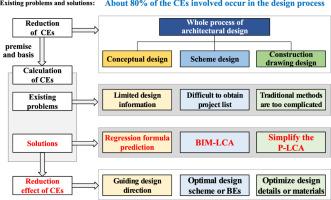Methods for calculating building-embodied carbon emissions for the whole design process
IF 6.3
3区 综合性期刊
Q1 Multidisciplinary
引用次数: 0
Abstract
Energy conservation and emissions reduction in the construction industry are important steps in achieving China's goals of peak carbon emissions by 2030 and carbon neutrality by 2060. The premise for building carbon emission (CE) reduction is to produce accurate CE calculations. Existing calculation methods for building CEs have many problems, such as complicated calculations, large data demands, time-consuming and laborious processes, weak design orientation of results, and poor feedback on emission reduction. At the same time, the calculation of CEs during the process of architectural design faces obstacles such as uncertainty of information, incomplete data, and difficulty in obtaining a bill of quantities based on design information. To resolve these obstacles, this study, based on a designer's vocabulary and thinking mode, describes the construction of a “design-oriented” calculation methods for building-embodied carbon emissions (ECEs). The prediction and assessment of the impact on the building environment during the architectural design process were helpful for identifying the key areas for carbon reduction, exploring potential emission reduction hotspots, and providing timely feedback for design optimization, which can have important theoretical value and practical significance in promoting the construction of low-carbon buildings.

计算整个设计过程中建筑所含碳排放量的方法
建筑行业的节能减排是中国实现2030年碳排放峰值和2060年碳中和目标的重要步骤。建筑碳减排的前提是进行准确的碳排放计算。现有的建筑能耗计算方法存在计算复杂、数据需求量大、过程耗时费力、结果设计导向不强、减排反馈不佳等问题。同时,建筑设计过程中ce的计算也面临着信息不确定性、数据不完整、基于设计信息难以获得工程量清单等障碍。为了解决这些障碍,本研究基于设计师的词汇和思维模式,描述了一种“以设计为导向”的建筑隐含碳排放(ECEs)计算方法的构建。在建筑设计过程中对建筑环境的影响进行预测和评估,有助于识别碳减排的重点领域,挖掘潜在的减排热点,为设计优化提供及时反馈,对推动低碳建筑的建设具有重要的理论价值和现实意义。
本文章由计算机程序翻译,如有差异,请以英文原文为准。
求助全文
约1分钟内获得全文
求助全文
来源期刊

Fundamental Research
Multidisciplinary-Multidisciplinary
CiteScore
4.00
自引率
1.60%
发文量
294
审稿时长
79 days
期刊介绍:
 求助内容:
求助内容: 应助结果提醒方式:
应助结果提醒方式:


